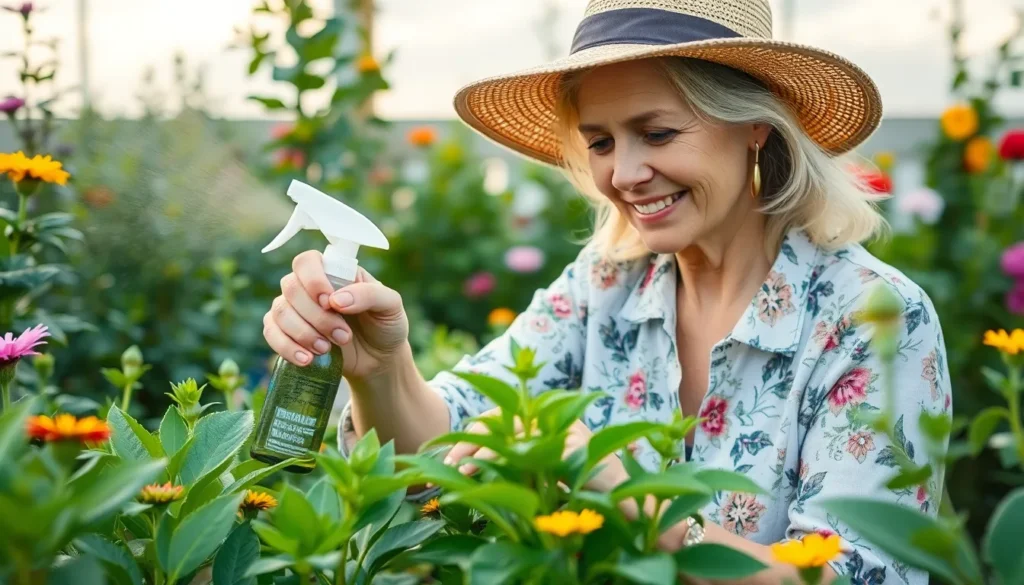We’ve all watched helplessly as our beautiful plants fall victim to pesky insects that seem to appear overnight. Whether it’s aphids destroying our roses or spider mites taking over our vegetable garden, these unwanted visitors can quickly turn our gardening dreams into nightmares.
The good news? We don’t need to reach for harsh chemical pesticides that can harm our environment, beneficial insects, and even our families. Natural insecticides offer a safer, more sustainable solution that’s both effective and eco-friendly. These plant-based alternatives work just as well as their chemical counterparts while protecting the delicate network we’ve worked so hard to create.
From simple soap sprays to powerful neem oil treatments, we’ll explore proven natural methods that keep harmful insects at bay without compromising our commitment to organic gardening. Ready to reclaim your garden naturally?
Neem Oil: The Most Versatile Natural Insecticide for Plants
Neem oil stands out as our top choice for natural pest control because it targets multiple garden threats while remaining safe for beneficial insects. This powerful extract from the neem tree offers gardeners a comprehensive solution that works against over 200 pest species.
How Neem Oil Works Against Garden Pests
Azadirachtin serves as neem oil’s primary active compound that disrupts insect hormone systems and feeding patterns. Soft-bodied pests like aphids, spider mites, and whiteflies become unable to molt properly when exposed to this natural hormone disruptor. Their reproductive cycles get interrupted, preventing new generations from establishing in your garden.
Contact action occurs when neem oil coats insects directly, suffocating them through their breathing pores called spiracles. Systemic protection develops as plants absorb the oil through their leaves, creating an internal defense system that repels pests for weeks. This dual-action approach makes neem oil more effective than many single-mechanism pesticides.
Feeding deterrent properties cause insects to avoid treated plants entirely, reducing damage before it starts. Adult insects often abandon areas where neem oil has been applied, seeking untreated vegetation elsewhere. Beneficial insects like bees and ladybugs remain largely unaffected because they don’t feed on plant tissues where neem concentrates.
Application Methods and Dosage Guidelines
Mixing ratios should follow a standard formula of 2 tablespoons of neem oil concentrate per gallon of water, plus 1 teaspoon of mild liquid soap as an emulsifier. Temperature considerations matter significantly since neem oil becomes less effective in temperatures above 85°F or below 40°F. We recommend applying treatments during cooler morning or evening hours for optimal results.
Spray coverage requires thorough coating of both leaf surfaces, focusing on undersides where many pests hide and lay eggs. Foliar application works best when leaves are dry and weather conditions remain calm to prevent drift. Weekly treatments during active growing seasons provide consistent protection against most common garden pests.
| Application Method | Dosage | Frequency | Best Timing |
|---|---|---|---|
| Foliar Spray | 2 tbsp/gallon water | Weekly | Early morning/evening |
| Soil Drench | 1 tbsp/gallon water | Bi-weekly | Before watering |
| Preventive Treatment | 1 tbsp/gallon water | Monthly | Growing season |
Soil drenching allows roots to absorb neem oil for systemic protection, using a lighter concentration of 1 tablespoon per gallon. Water thoroughly after application to help plants uptake the treatment through their root systems. Storage requirements include keeping neem oil in cool, dark places since light and heat break down its active compounds quickly.
Diatomaceous Earth: Nature’s Microscopic Pest Warrior
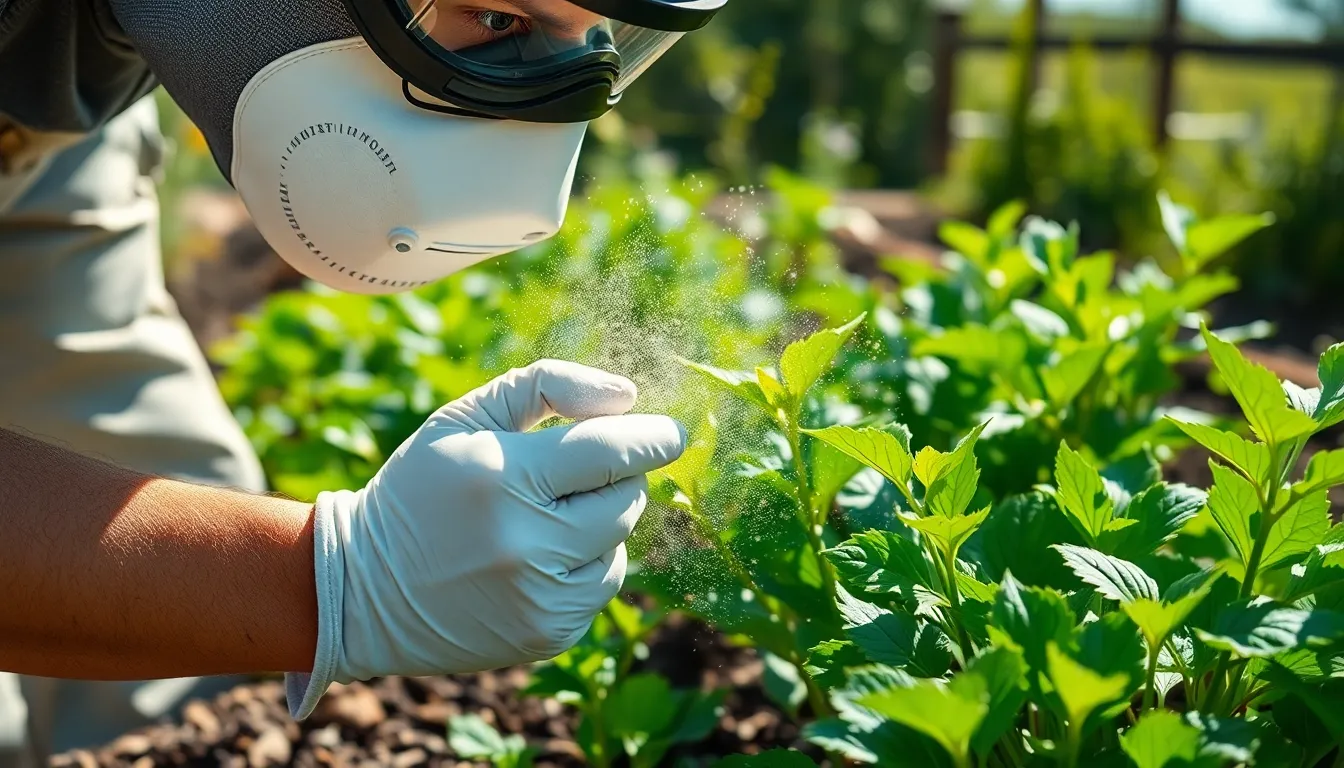
While neem oil offers excellent systemic protection, diatomaceous earth provides a completely different approach to natural pest control. This fossilized algae powder works mechanically rather than chemically, making it an ideal complement to our organic gardening arsenal.
Food-Grade vs. Pool-Grade: Choosing the Right Type
Food-grade diatomaceous earth stands as the only safe choice for garden pest control applications. We recommend this type because it’s completely non-toxic to humans, pets, and beneficial wildlife in our gardens.
Pool-grade diatomaceous earth undergoes different processing for swimming pool filtration systems. This version contains crystalline silica that can be harmful, making it unsuitable for any gardening or pest control purposes.
Safety considerations make food-grade DE our preferred option since it maintains its pest-killing effectiveness without introducing dangerous chemicals into our growing environment. The microscopic silica particles in food-grade DE retain their sharp, abrasive properties while remaining safe around our plants and families.
Safe Application Techniques for Maximum Effectiveness
Direct dusting around plant bases creates an effective barrier against crawling insects like ants, earwigs, and silverfish. We apply a thin layer of food-grade DE in a circle around vulnerable plants, focusing on areas where pests typically travel.
Leaf application works particularly well for deterring feeding insects on foliage crops. Dusting the undersides and tops of leaves creates a protective coating that discourages pests from settling and feeding on our plants.
Soap mixture enhancement significantly improves DE’s effectiveness against soft-bodied pests like mealybugs and spider mites. Research shows that combining diatomaceous earth with mild liquid soap in water solution delivers faster pest reduction than neem oil or soapy water alone.
Weather timing plays a crucial role in DE application success. We avoid applying diatomaceous earth during wet conditions since moisture reduces its drying ability, and we always reapply after rain or heavy watering sessions.
Safety precautions include wearing a dust mask during application to prevent inhaling the fine powder particles. While food-grade DE is non-toxic, respiratory protection ensures comfortable and safe application every time.
Essential Oil Blends: Aromatic Protection for Your Garden

Essential oils provide powerful natural alternatives that combine effectiveness with garden safety, offering aromatic protection through proven plant compounds.
Peppermint and Rosemary Oil Combinations
Rosemary oil contains potent insecticidal compounds including camphor, α-pinene, and 1,8-cineole that act as natural pest irritants. We’ve found that combining rosemary with peppermint oil creates synergistic effects that enhance insecticidal efficiency while broadening the spectrum of targeted pests. These aromatic blends work by disrupting insect behavior patterns and feeding mechanisms naturally.
Field studies demonstrate remarkable results when using commercial blends containing rosemary oil. Research on blueberries and strawberries showed that Ecotrol, which includes rosemary oil among its active ingredients, performed as effectively as synthetic insecticides against Spotted-Wing Drosophila. The study particularly highlighted strong performance during early and late pest seasons, supporting essential oil blends as viable alternatives to chemical pesticides.
Aromatic plants like Satureja montana provide additional options through their rich carvacrol and thymol content. Studies show these compounds deliver strong antifeedant and toxic effects against various garden pests, making them valuable components in sustainable biopesticide development.
Citrus Oil Formulations for Aphid Control
Citrus oils rich in limonene demonstrate exceptional effectiveness against soft-bodied pests, particularly aphids that commonly plague garden plants. We recommend citrus-based formulations because they disrupt insect feeding behavior while reducing infestation rates through natural repellent properties. These oils work by interfering with pest communication and movement patterns without harming beneficial pollinators.
Natural citrus sprays offer targeted aphid control while maintaining environmental safety standards that protect garden ecosystems. Limonene compounds penetrate soft insect exoskeletons, causing dehydration and mortality in aphid populations. The aromatic properties simultaneously create protective barriers that discourage new infestations from establishing on treated plants.
Applications remain simple and effective when using citrus oil formulations correctly. We suggest mixing citrus oils with mild carrier answers to improve coverage and adherence on plant surfaces. Regular applications during peak aphid seasons provide consistent protection while supporting integrated pest management strategies that reduce synthetic pesticide dependency.
Soap-Based Sprays: Gentle Yet Effective Plant Protection
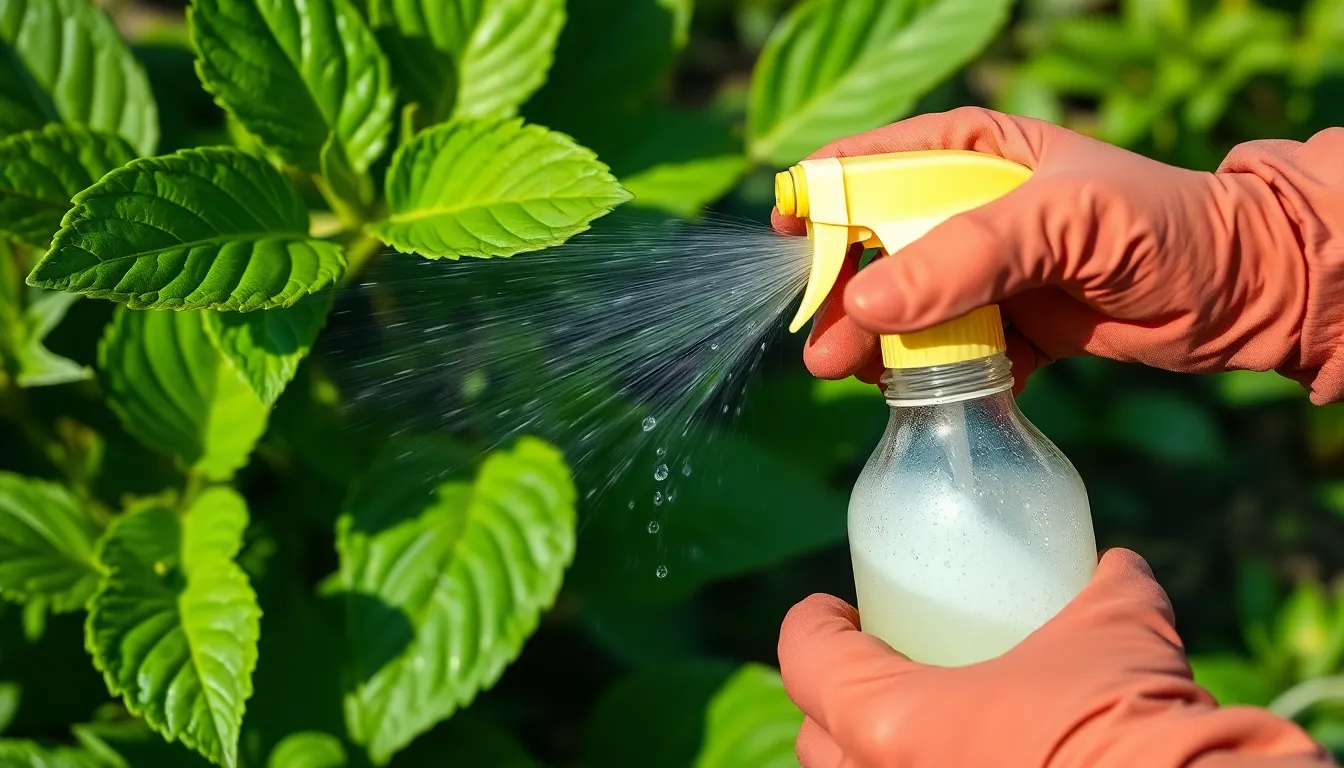
We’ve found that soap-based insecticidal sprays offer one of the most accessible and environmentally friendly approaches to controlling soft-bodied pests like aphids and mites. These gentle answers work by breaking down the insect’s outer waxy coating, causing dehydration and death without harming beneficial insects when used correctly.
Castile Soap Solution Recipes
Prepare your Castile soap solution by diluting 1-2 tablespoons of pure Castile soap in 1 gallon of water for optimal effectiveness. This biodegradable formula provides excellent coverage against soft-bodied insects while remaining gentle on plant foliage.
Mix the solution thoroughly before each application to ensure even distribution of soap particles throughout the water. We recommend using lukewarm water to help the soap dissolve completely and create a more effective spray consistency.
Apply the solution directly onto affected plants during early morning or evening hours when temperatures are cooler. Target the undersides of leaves where pests commonly hide, ensuring good coverage without oversaturating the plant tissue.
Test a small section of your plant first to check for any sensitivity before treating the entire plant. Most plants tolerate Castile soap well, but some delicate varieties may show signs of stress with concentrated applications.
Dawn Dish Soap Alternative Methods
Dilute Dawn dish soap to a much weaker concentration than Castile soap, using only 1 teaspoon per gallon of water to prevent plant damage. This common household alternative can be effective against pests but requires careful application to avoid burning sensitive plant tissues.
Spray the diluted Dawn solution sparingly on affected areas, focusing on pest clusters rather than covering entire plants. We’ve observed that excessive application can strip natural protective oils from plant leaves, making them more susceptible to environmental stress.
Monitor your plants closely after Dawn soap applications, as synthetic detergents can be harsher than natural alternatives. Watch for signs of leaf yellowing, browning, or wilting that may indicate the concentration is too strong for your exact plants.
Rinse treated plants with clean water 2-3 hours after application to remove soap residue and prevent potential buildup. This extra step helps maintain plant health while still providing effective pest control benefits.
Garlic and Onion Sprays: Pungent Pest Deterrents
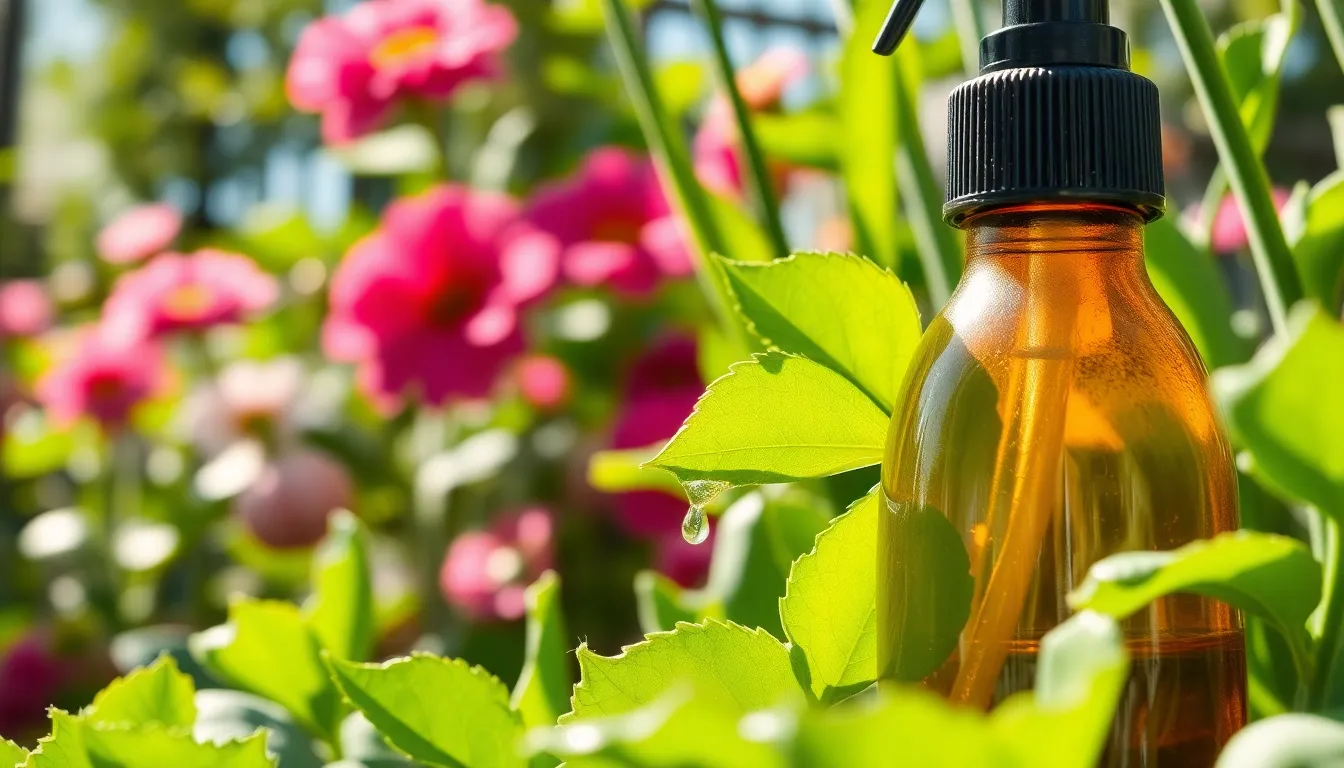
Building on our soap spray foundation, we can harness the natural pest-repelling power of garlic and onion compounds. These aromatic bulbs create potent sprays that deter insects through their strong sulfur compounds.
Preparation and Brewing Techniques
Basic cooking method starts with one head of garlic and half a large onion cooked down until liquified, then mixed with water and cooled before application. This simple approach creates an effective base spray that we can use immediately after cooling.
Blended spray preparation combines pulverized garlic, onion, peppermint, and cayenne pepper in a blender for maximum potency. We let this mixture steep for several hours to extract the strongest compounds, then strain it thoroughly through fine mesh or cheesecloth to prevent sprayer clogs.
Oil infusion technique involves crushing fresh garlic cloves and infusing them into food-grade sunflower oil for 24 hours. We then mix this concentrated oil with water and lemon juice for a lighter application that won’t overwhelm plant surfaces.
Enhanced formulations can include eucalyptus or tea tree oils at a 1:10 ratio with sunflower oil for stronger bug repellent action. Natural liquid castile soap helps our spray adhere better to plant surfaces and increases effectiveness against pest insects.
Testing on a single leaf for 24 hours before wider application helps us gauge plant tolerance and prevents damage to sensitive varieties.
Target Pests and Application Schedule
Primary target pests include aphids, mosquitoes, caterpillars, beetles, and mites that find the pungent smell and sulfur compounds distasteful. These insects avoid treated plants due to the overwhelming odor that disrupts their feeding patterns.
Application frequency works best at 1-2 times per week or immediately after heavy rain to maintain protective coverage on plant surfaces. We spray affected plant parts during cooler morning or evening hours to prevent leaf burn and maximize absorption.
Coverage strategy focuses on undersides of leaves and stems where pests typically congregate, while avoiding direct application on edible parts when possible to minimize strong odors on harvested crops.
Complementary practices like maintaining good plant health, controlling weeds, and adding organic soil matter enhance the effectiveness of our garlic and onion sprays. These natural methods protect vegetables, flowers, and ornamental plants without introducing harmful chemicals that could damage beneficial insects or soil microorganisms.
Beneficial Bacteria Solutions: Biological Warfare Against Insects
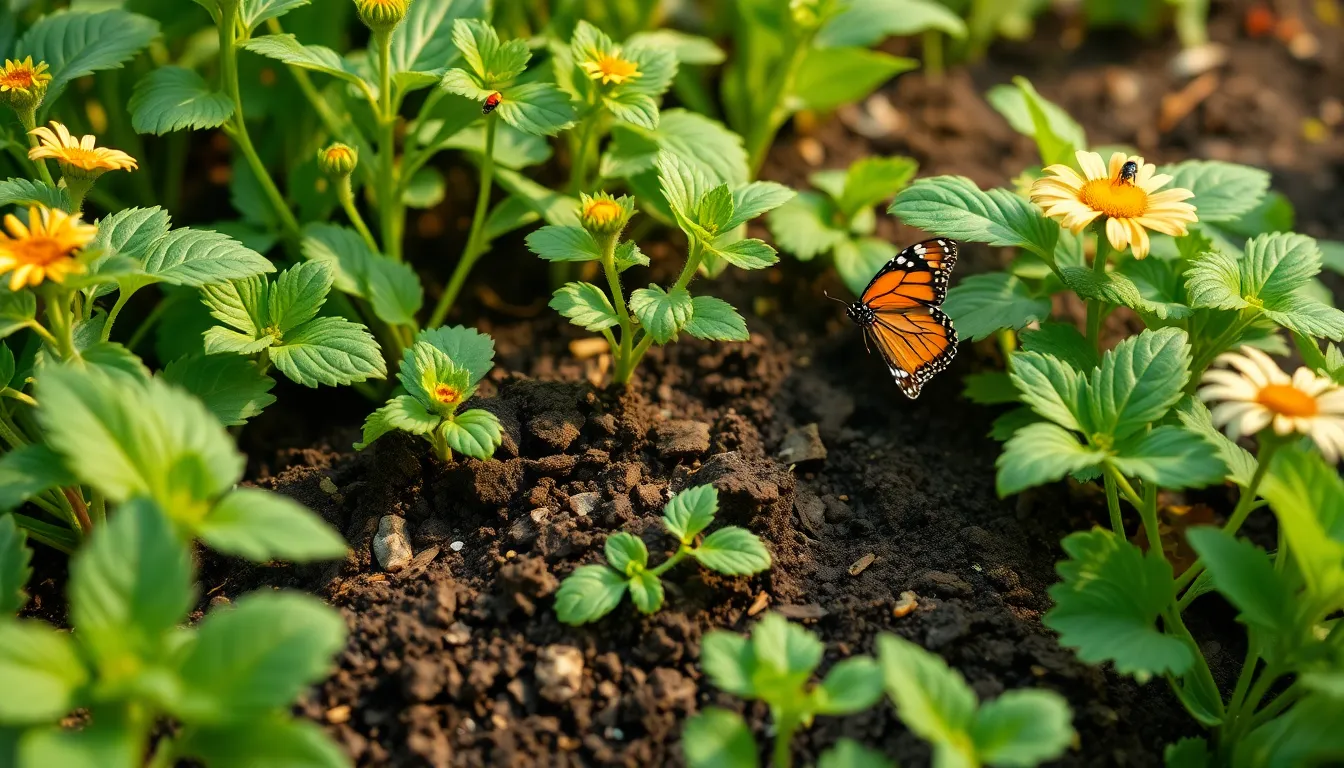
Nature provides us with powerful allies in the form of beneficial bacteria that wage war against garden pests. These microscopic warriors offer targeted pest control while preserving the ecological balance we’ve worked hard to maintain.
Bacillus Thuringiensis Applications
Bacillus thuringiensis (Bt) stands as one of the most effective biological weapons in our natural pest control arsenal. This soil-dwelling bacterium produces proteins that become toxic to exact insect larvae once ingested, making it incredibly precise in targeting pests like caterpillars and beetles.
Target effectiveness reaches remarkable levels with Bt applications. We’ve seen success rates of 50-100% against targeted pests in controlled studies, proving its reliability as a chemical pesticide alternative. Caterpillars feeding on Bt-treated plants experience disrupted digestive systems, eventually leading to their elimination without affecting beneficial insects.
Application timing plays a crucial role in maximizing Bt’s effectiveness. We recommend applying Bt formulations during early morning or evening hours when target larvae are most active. Young caterpillars prove most susceptible to Bt toxins, so early intervention provides the best results.
Safety advantages make Bt particularly appealing for organic gardening practices. Unlike synthetic pesticides, Bt poses no threat to humans, beneficial insects, or soil microorganisms. This specificity allows us to maintain integrated pest management strategies without disrupting natural ecosystems.
Beneficial Nematode Introductions
Beneficial nematodes represent another powerful biological control method that targets soil-dwelling pests. These microscopic worms actively hunt down grubs, root weevils, and vine borers, releasing bacteria that eliminate pests from within.
Application methods require exact techniques to ensure nematode survival and effectiveness. We apply these beneficial organisms as soil drenches during cooler parts of the day, typically in early morning or evening when soil temperatures remain moderate. Maintaining soil moisture after application helps nematodes establish themselves and begin their pest-hunting activities.
Targeted pest control makes nematodes particularly valuable for addressing underground pest problems. Root weevils, grubs, and other soil-dwelling larvae become vulnerable to nematode parasitism once these beneficial organisms establish themselves in the soil environment. This biological approach reduces our reliance on chemical soil treatments.
Environmental benefits extend beyond immediate pest control when we introduce beneficial nematodes. These organisms promote soil health by breaking down organic matter and creating beneficial microbial communities. Their presence indicates healthy soil ecosystems that naturally resist pest invasions over time.
Coffee Grounds and Tea Remedies: Repurposing Kitchen Waste
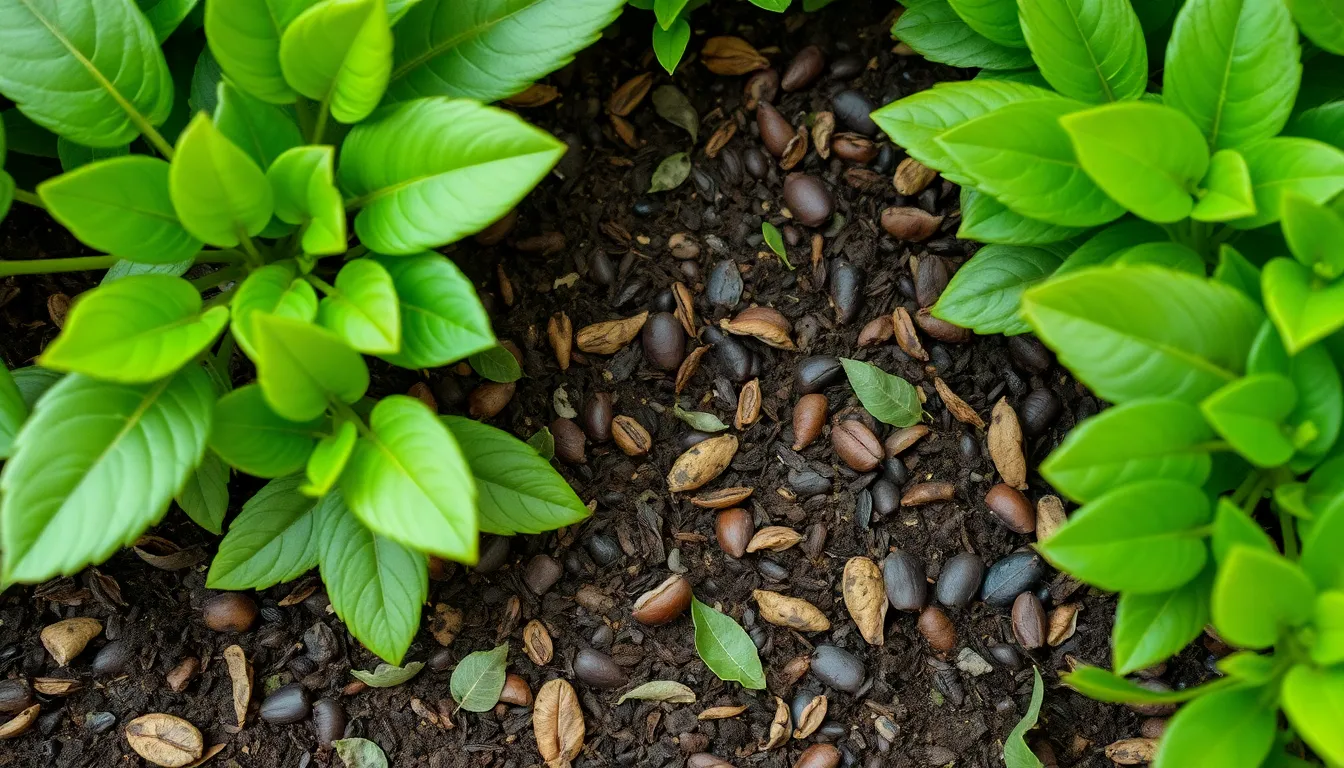
We’re transforming everyday kitchen waste into powerful natural pest control answers. Coffee grounds and used tea leaves contain bioactive compounds that create effective barriers against garden pests.
Caffeine-Based Deterrent Properties
Caffeine acts as a natural feeding deterrent that interferes with insect nervous systems and reduces pest activity. Research demonstrates that caffeine containing plant extracts provide important control against both larval and adult stages of many garden pests. Coffee plants and tea plants naturally produce this secondary compound as their own defense mechanism against insects.
Strong odors from coffee grounds repel certain insect pests when we apply them directly around plant bases. Tea leaves also contain natural phenolic compounds that inhibit insect feeding behavior on contact. Both materials work through multiple pathways to create hostile environments for common garden pests.
Nervous system disruption occurs when insects encounter caffeine based deterrents in sufficient concentrations. Studies show that these compounds affect pest feeding patterns and reproduction cycles. Field applications of coffee grounds demonstrate measurable reductions in plant damage from various insect species.
Composting Integration Methods
Enriched compost provides slow release benefits when we incorporate coffee grounds and tea leaves into our composting systems. Breaking down these organic materials enhances soil microbiome diversity while maintaining pest deterrent properties. Regular applications of this enriched compost support integrated pest management by reducing chemical insecticide dependence.
Soil health improvements occur naturally as composted coffee and tea materials decompose and release nutrients. Enhanced plant resilience results from improved soil fertility and stronger root systems. Healthy plants grown in this enriched soil show increased resistance to pest infestations and recover more quickly from damage.
Application methods include direct mulching around plant bases or brewing concentrated sprays for foliar treatment. We can apply coffee grounds as surface mulch to create immediate pest barriers. Tea leaf compost works effectively when mixed into soil amendments or applied as top dressing around vulnerable plants.
Cost effective answers emerge from repurposing these readily available kitchen wastes instead of purchasing commercial pesticides. Sustainable pest management becomes achievable through consistent application of these natural materials. Environmental benefits multiply as we reduce both household waste and synthetic chemical usage in our gardens.
Companion Planting: Living Natural Insecticide Systems
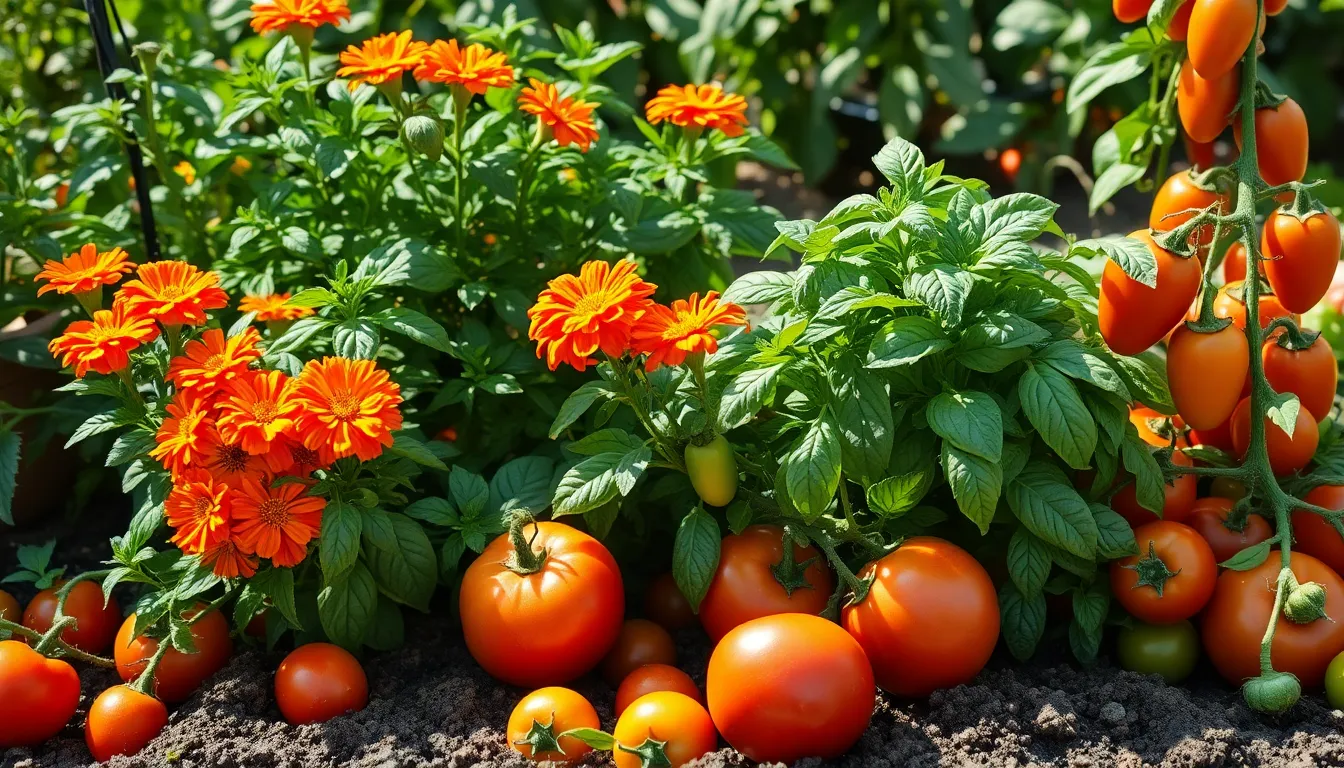
We’re shifting from applying external treatments to creating self-sustaining pest protection through strategic plant partnerships. These living systems work continuously to repel pests without any additional effort from us.
Marigold and Basil Protective Partnerships
Marigolds create powerful chemical barriers by producing compounds that naturally repel nematodes and various insect pests. These vibrant flowers release pyrethrum and other pest-deterrent chemicals through their roots and foliage. Basil contributes its own arsenal of protection by emitting strong aromatic oils that specifically target flies and mosquitoes.
Together, these companion plants form a dual defense system that confuses herbivorous insects and disrupts their feeding patterns. We’ve found that positioning marigolds and basil near tomatoes, peppers, and other vegetable crops significantly reduces pest pressure. The combination works by creating overlapping zones of natural chemical protection that pests instinctively avoid.
Benefits extend beyond pest control as both plants attract beneficial pollinators while simultaneously repelling harmful insects. This partnership proves especially effective against aphids, whiteflies, and various moth species that commonly attack vegetable gardens.
Strategic Garden Layout Planning
Positioning pest-repelling plants throughout our gardens requires thoughtful planning to maximize their protective coverage. We need to create interconnected zones where companion plants support each other while protecting more vulnerable crops. Border plantings of strong-scented herbs like lavender, rosemary, and sage establish perimeter defenses against flying insects.
Interspersing aromatic plants among susceptible vegetables creates multiple layers of natural protection. Strategic placement involves positioning taller pest-deterrent plants on the windward side to carry their protective scents across the garden. We should also cluster similar pest-repelling plants to intensify their combined effects in high-risk areas.
Pathways between garden beds benefit from pest-repelling ground covers that release protective compounds when walked upon. This systematic approach exploits natural chemical defenses and insect behaviors to create comprehensive protection without relying on external treatments. Regular observation helps us identify which plant combinations work most effectively in our exact growing conditions.
Homemade Pyrethrin Alternatives: Chrysanthemum-Based Solutions

Building on our foundation of natural pest control methods, we can create powerful homemade pyrethrin alternatives from chrysanthemum flowers. These natural compounds target the nervous system of insects like aphids and spider mites, causing paralysis and death while remaining relatively safe for humans and beneficial insects.
Flower Extraction Processes
Harvesting chrysanthemum flowers requires precise timing to maximize pyrethrin potency. We collect flowers when they’re fully mature but before wilting begins, focusing on Chrysanthemum cinerariifolium and Chrysanthemum coccineum varieties for the highest active compound yield.
Drying the harvested flowers in shade preserves the pyrethrin compounds that sunlight would otherwise degrade. We spread the flowers on screens or paper in a well-ventilated area away from direct light, allowing natural air circulation to remove moisture over several days.
Grinding the dried flowers into powder creates the base material for extraction. We use a coffee grinder or mortar and pestle to break down the flower material, releasing the concentrated pyrethrin compounds stored within the petals.
Simple extraction methods work well for home gardeners without access to laboratory equipment. We can soak crushed dried chrysanthemum flowers in rubbing alcohol for 24-48 hours, then strain the liquid to create a crude insecticidal spray that targets over 200 pest species.
Water-based extraction offers another accessible approach for organic gardeners. We steep the powdered flowers in hot water for several hours, creating a tea-like solution that can be strained and diluted for garden application.
Safety Considerations and Storage
Light sensitivity makes proper storage crucial for maintaining pyrethrin effectiveness. We store homemade extracts in dark, airtight containers away from heat and sunlight, as these natural compounds degrade quickly when exposed to UV rays and oxygen.
Immediate use ensures maximum potency of our homemade pyrethrin alternatives. We prepare small batches that can be used within a few days to weeks, as the active compounds lose their insecticidal properties over time.
Protective equipment should be worn during preparation and application of chrysanthemum extracts. We recommend gloves and eye protection, as these natural compounds can cause skin irritation and respiratory issues in sensitive individuals.
Environmental precautions must be taken when applying pyrethrin alternatives near water sources. We avoid spraying near ponds, streams, or aquariums, as pyrethrins can be toxic to fish and aquatic life even in small concentrations.
Pet safety requires special attention when using chrysanthemum-based sprays around cats and dogs. We apply treatments when pets aren’t present and allow surfaces to dry completely before allowing animal access to treated areas.
Clear labeling prevents accidental ingestion or misuse of stored extracts. We label all containers with contents, preparation date, and usage instructions, storing them in secure locations away from children and pets.
Cool storage in temperatures below 70°F extends the shelf life of our homemade pyrethrin answers. We keep containers in basements, pantries, or refrigerators to slow the natural degradation process that heat accelerates.
Application Timing and Seasonal Strategies
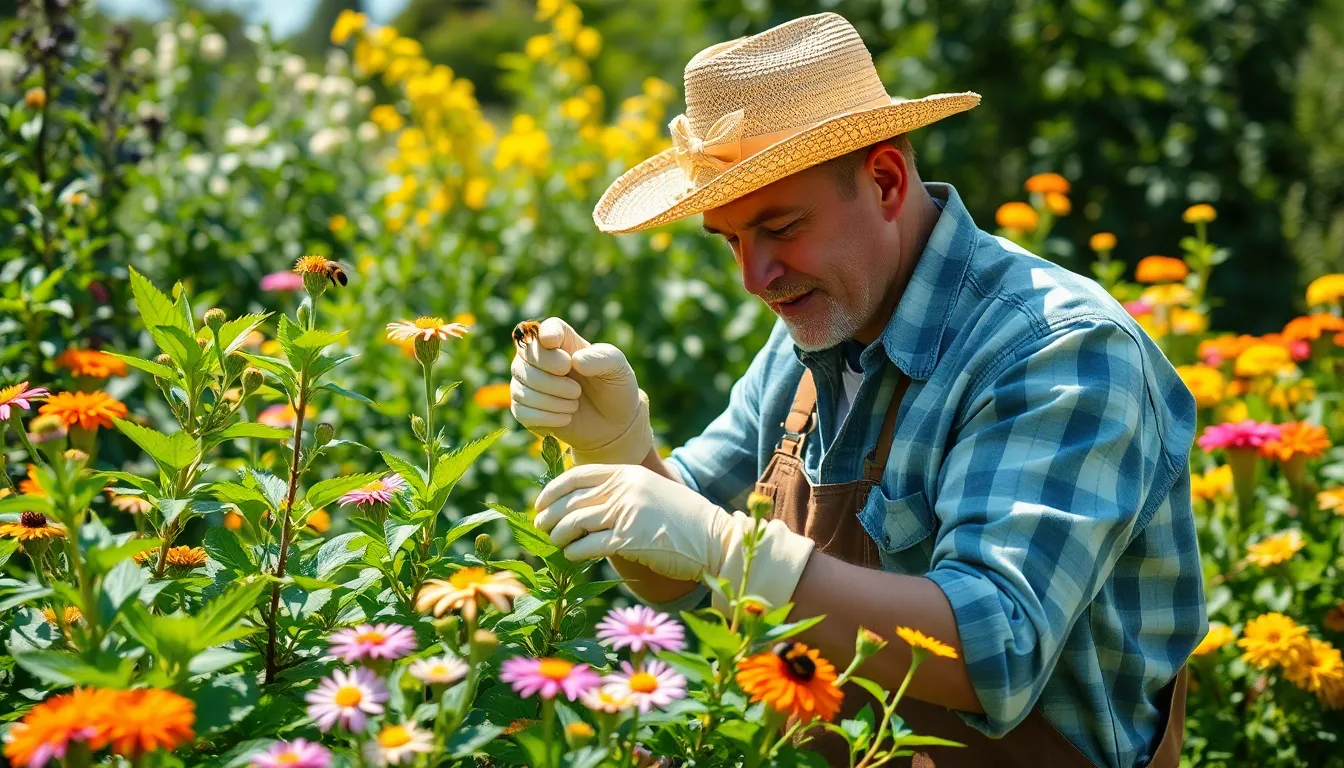
Timing our natural insecticide applications correctly makes the difference between success and disappointment in pest control. Strategic scheduling protects both our plants and beneficial insects while maximizing treatment effectiveness.
Early Morning vs. Evening Treatment Benefits
Early morning application delivers optimal results because cooler temperatures reduce plant stress and prevent leaf burn. We recommend spraying between 6-8 AM when temperatures remain below 70°F, allowing the insecticide to dry before heat intensifies. Morning treatments also increase product effectiveness since many natural compounds volatilize less in cool conditions.
Evening application serves as our second-best option, particularly when protecting pollinators becomes a priority. Spraying at dusk around 6-8 PM reduces exposure to bees and other beneficial insects that remain active during daylight hours. Evening treatments work especially well after plant bloom periods when pollinator activity decreases naturally.
Midday application should be avoided because intense sunlight and heat can cause rapid product breakdown and potential plant damage. High temperatures increase the risk of leaf burn, especially with oil-based treatments like neem oil or essential oil blends. Hot conditions also reduce coverage effectiveness as spray droplets evaporate before reaching target pests.
Seasonal Pest Cycle Considerations
Spring applications target emerging pest populations before they establish colonies and spread throughout our gardens. We apply treatments as soon as we detect the first signs of pest activity, typically when temperatures consistently reach 60°F and new growth appears. Early intervention during growing season prevents small infestations from becoming major problems.
Summer treatments require careful timing around plant bloom periods to protect pollinators visiting our flowers. We avoid spraying during peak flowering and instead target late flowering or post-bloom periods when beneficial insect activity decreases. Weekly reapplication becomes necessary during summer months since natural insecticides degrade faster in heat and sunlight.
Fall applications focus on overwintering pest stages and preparation for next season’s protection. We target adult pests seeking shelter and egg-laying sites before winter dormancy begins. Understanding each pest’s life cycle guides our timing decisions, such as targeting larvae before they mature into reproductive adults.
Weather-dependent scheduling ensures maximum effectiveness of our natural treatments. We apply when soil remains moderately dry and no rain is forecasted for 24-48 hours, allowing better absorption and persistence. Reapplication after rain becomes essential since most natural insecticides wash away more easily than synthetic alternatives.
Conclusion
We’ve equipped you with a comprehensive toolkit of natural insecticides that’ll transform your approach to garden pest management. From neem oil’s systemic protection to diatomaceous earth’s mechanical barriers these methods prove that effective pest control doesn’t require harsh chemicals.
The beauty of natural pest control lies in its versatility. Whether you’re brewing garlic sprays from kitchen scraps or strategically planting marigolds for companion protection you’re creating a sustainable network that works with nature rather than against it.
Remember that timing and consistency are your greatest allies. Early morning applications weather-aware scheduling and seasonal adjustments will maximize your success while protecting beneficial insects and pollinators.
By embracing these natural methods you’re not just solving today’s pest problems—you’re building a healthier more resilient garden for the future. Your plants your family and the environment will thank you for making the switch to these eco-friendly alternatives.
Frequently Asked Questions
What are the main benefits of using natural insecticides over chemical pesticides?
Natural insecticides are safer for the environment, beneficial insects, and human health. They don’t leave harmful residues on plants or in soil, making them ideal for organic gardening. Unlike harsh chemicals, natural alternatives like neem oil and soap sprays effectively control pests while maintaining the garden’s ecological balance and protecting pollinators.
How does neem oil work as a natural pest control method?
Neem oil contains azadirachtin, which disrupts insect hormone systems and feeding patterns. It works through dual action: suffocating pests on contact and providing systemic protection when absorbed by plants. This natural insecticide targets over 200 pest species while being safe for beneficial insects, offering weeks of protection with proper application.
What’s the difference between food-grade and pool-grade diatomaceous earth?
Food-grade diatomaceous earth is safe for gardening and contains less than 1% crystalline silica, making it non-toxic to humans and pets. Pool-grade DE contains high levels of crystalline silica and is chemically treated, making it dangerous for garden use. Always choose food-grade DE for pest control applications.
Which essential oils are most effective for natural pest control?
Peppermint and rosemary oil blends are highly effective against various pests, showing results comparable to synthetic insecticides. Citrus oils containing limonene work exceptionally well against aphids by disrupting their feeding behavior. These oils should be properly diluted and applied during cooler parts of the day for best results.
How do soap-based insecticidal sprays eliminate pests?
Soap sprays work by breaking down the waxy coating on soft-bodied insects like aphids and spider mites, causing dehydration and death. Use 1-2 tablespoons of Castile soap per gallon of water, or a weaker concentration of Dawn dish soap. Apply during cooler times and rinse plants afterward to prevent residue buildup.
What makes garlic and onion sprays effective pest deterrents?
Garlic and onion contain strong sulfur compounds that repel insects naturally. These sprays are particularly effective against aphids, mosquitoes, and other soft-bodied pests. Apply 1-2 times weekly, focusing on leaf undersides. The strong scent masks plant odors that attract pests while being completely safe for beneficial insects.
How do beneficial bacteria like Bacillus thuringiensis work?
Bacillus thuringiensis (Bt) is a naturally occurring bacteria that produces toxins lethal to specific insect larvae. It’s highly targeted, killing only harmful caterpillars and larvae while leaving beneficial insects unharmed. Bt must be ingested by pests to be effective, making proper timing during active feeding periods crucial for success.
Can coffee grounds and tea leaves really control garden pests?
Yes, coffee grounds and tea leaves contain caffeine and other compounds that disrupt insect nervous systems. They can be applied directly around plants or composted to improve soil health. These kitchen waste materials create natural barriers against pests while providing additional nutrients to plants and reducing household waste.
What is companion planting and how does it help with pest control?
Companion planting involves strategically placing pest-repelling plants like marigolds and basil near vulnerable crops. These plants release natural chemicals that deter pests while attracting beneficial insects. This method creates a self-sustaining protection system that reduces the need for external treatments and promotes biodiversity in the garden.
When is the best time to apply natural pest control treatments?
Early morning applications are optimal as cooler temperatures reduce plant stress and enhance product effectiveness. Evening applications protect daytime pollinators, while midday treatments should be avoided to prevent plant damage. Weather conditions matter too – apply treatments when rain isn’t expected for at least 24 hours for maximum effectiveness.
How often should I apply natural pest control methods?
Application frequency depends on the method and pest pressure. Soap sprays and essential oils may need weekly applications, while neem oil can provide protection for several weeks. Garlic sprays should be applied 1-2 times weekly or after rain. Monitor pest activity and adjust frequency based on infestation levels and weather conditions.
Are natural pest control methods safe around pets and children?
Most natural pest control methods are significantly safer than chemical alternatives. Food-grade diatomaceous earth, soap sprays, and essential oils pose minimal risk when used properly. However, always wear protective equipment during application, store materials safely, and avoid direct contact with pets during treatment. Read all safety guidelines before use.

